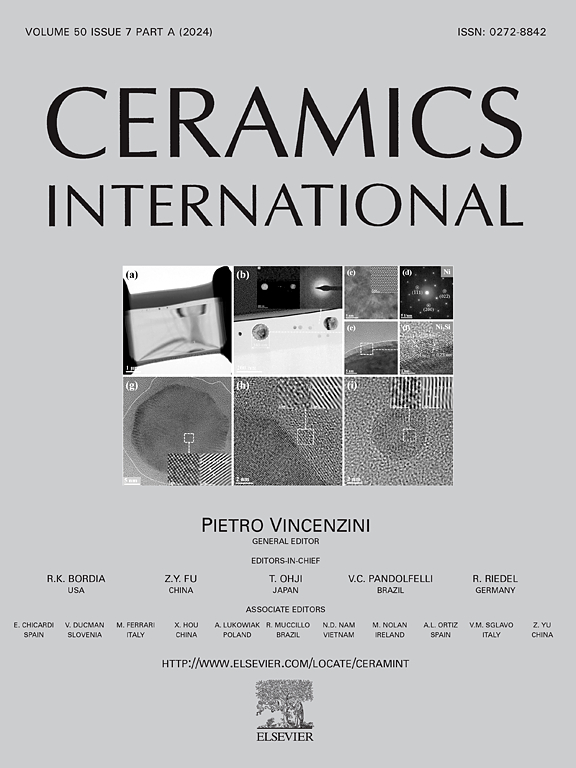无容器熔炼-凝固法制备ZrO2-Al2O3-SiO2三元陶瓷复合材料
IF 5.6
2区 材料科学
Q1 MATERIALS SCIENCE, CERAMICS
引用次数: 0
摘要
化学成分上有限的灵活性限制了ZrO2-Al2O3二元陶瓷复合材料(BCCs)的微观结构和性能调节的可能性。因此,引入第三相制备三元陶瓷复合材料具有重要意义。在本研究中,加入固定比例的无定形SiO2 (30 mol%)作为第三相,制备了具有不同Zr/Al比的ZrO2-Al2O3-SiO2三元陶瓷纳米复合材料(TCNCs)。tcnc采用无容器空气动力学悬浮技术制造,该技术具有较大的热梯度,有利于纳米共晶的形成。在Zr/Al比为3:1的样品中,单斜晶相ZrO2是唯一的结晶相。根据加工温度的不同,Al元素存在于Al- o - si或Al- o玻璃相中;Zr/Al比为3:8时,形成了ZrO2-Al2O3纳米共晶,并伴有莫来石晶体的生成。SiO2相为非晶态基质。Zr/Al比为3:8的TCNC的维氏硬度与ZrO2-Al2O3复合材料的维氏硬度相当。本文章由计算机程序翻译,如有差异,请以英文原文为准。
A containerless melting-solidification strategy to fabricate ZrO2-Al2O3-SiO2 ternary ceramic composites containing crystalline and amorphous phases
The limited flexibility in terms of chemical composition restricts the microstructure and property regulation possibilities of ZrO2-Al2O3 binary ceramic composites (BCCs). Therefore, it is significant to prepare ternary ceramic composites by introducing a third phase. In this study, a fixed proportion of amorphous SiO2 (30 mol%) was incorporated as the third phase to develop ZrO2-Al2O3-SiO2 ternary ceramic nanocomposites (TCNCs) with two distinct Zr/Al ratios. The TCNCs were fabricated using containerless aerodynamic levitation technology, which featured a large thermal gradient that would facilitate the formation of nano-eutectics. In samples with a Zr/Al ratio of 3:1, monoclinic ZrO2 was the sole crystalline phase. The Al element was present in either Al-O-Si or Al-O glass phase, depending on the processing temperature; In contrast, ZrO2-Al2O3 nano-eutectics were formed in samples with a Zr/Al ratio of 3:8, accompanied by the generation of mullite crystallites. The SiO2 phase functioned as an amorphous matrix. Vickers hardness of the TCNC with a Zr/Al ratio of 3:8 exhibited comparability to that reported for ZrO2-Al2O3 composites.
求助全文
通过发布文献求助,成功后即可免费获取论文全文。
去求助
来源期刊

Ceramics International
工程技术-材料科学:硅酸盐
CiteScore
9.40
自引率
15.40%
发文量
4558
审稿时长
25 days
期刊介绍:
Ceramics International covers the science of advanced ceramic materials. The journal encourages contributions that demonstrate how an understanding of the basic chemical and physical phenomena may direct materials design and stimulate ideas for new or improved processing techniques, in order to obtain materials with desired structural features and properties.
Ceramics International covers oxide and non-oxide ceramics, functional glasses, glass ceramics, amorphous inorganic non-metallic materials (and their combinations with metal and organic materials), in the form of particulates, dense or porous bodies, thin/thick films and laminated, graded and composite structures. Process related topics such as ceramic-ceramic joints or joining ceramics with dissimilar materials, as well as surface finishing and conditioning are also covered. Besides traditional processing techniques, manufacturing routes of interest include innovative procedures benefiting from externally applied stresses, electromagnetic fields and energetic beams, as well as top-down and self-assembly nanotechnology approaches. In addition, the journal welcomes submissions on bio-inspired and bio-enabled materials designs, experimentally validated multi scale modelling and simulation for materials design, and the use of the most advanced chemical and physical characterization techniques of structure, properties and behaviour.
Technologically relevant low-dimensional systems are a particular focus of Ceramics International. These include 0, 1 and 2-D nanomaterials (also covering CNTs, graphene and related materials, and diamond-like carbons), their nanocomposites, as well as nano-hybrids and hierarchical multifunctional nanostructures that might integrate molecular, biological and electronic components.
 求助内容:
求助内容: 应助结果提醒方式:
应助结果提醒方式:


